Fraser Island Hoon Tourism out of control
Friday, August 3rd, 2012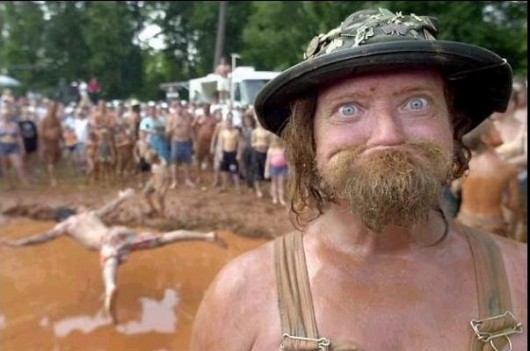 Hoon Tourism
Hoon Tourism
.
Tourism on Queensland’s Fraser Island is worse than ‘uncontrolled’, it is out of control.
Any Tom, Dick or Harry can get a permit for their 4WD online and take it across on one of the barges to Fraser Island so they can speed along the beaches and hoon over the dunes at their leisure. The hoons know that there is a police station near Kingfisher Resort, but manned by only a few and to the hoons Fraser Island is a free-for-all hoot by day and piss-up by night.
Where are the statistics on tourists fined, evicted, loss of licence for hooning on Fraser Island? After all, the allowed speed limit on the Seventy-Mile Beach is 80kph! Where else in Australia can hoons, hoon along the beach at 80kph? Who’s to stop them going faster?
.
Fraser Island is alcohol fueled
.
And before a hoon party even arrives on Fraser Island, they have plenty of choices where to stock up on booze. Driving north from Brisbane into Maryborough, there’s the Carriers Arms Hotel, White Lion Hotel, Westside Cellars, Dan Murphy’s and Liquor Stax.
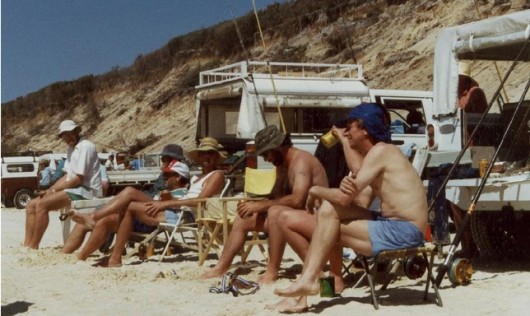 Unlimited drinking anywhere on Fraser Island
Unlimited drinking anywhere on Fraser Island
.
At the 4WD Barge ramp at River Heads there is ‘Cellarbrations’ or at Hervey Bay there is the Kondari Hotel, and a choice of two Liquorwise outlets (odd name) plus another Dan Murphy’s. But fear not, if once on Fraser Island, hoons have run dry, then without having to leave the island, they can restock on booze at the general store at Eurong Beach Resort or at Kingfisher Bay Resort.
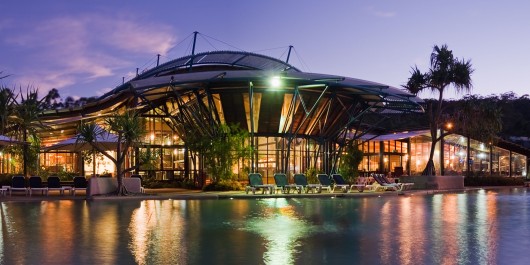 Kingfisher Resport, Fraser Island – promoting partying on Fraser Island
Kingfisher Resport, Fraser Island – promoting partying on Fraser Island
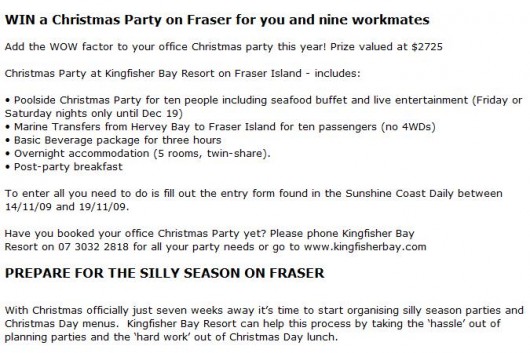 Source: ^http://www.sunshinecoastdaily.com.au/winanofficeparty/
Source: ^http://www.sunshinecoastdaily.com.au/winanofficeparty/
.
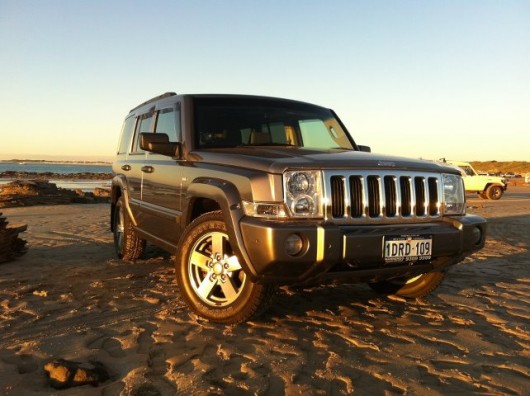 Chrysler’s Jeep Australia brand currently promotes its 4WD vehicles for beach usage
Chrysler’s Jeep Australia brand currently promotes its 4WD vehicles for beach usage
.
In January 2012, Fraser Island Police charged a 48-year-old Australian Capital Territory man, seated in the front passenger seat, with drink driving (in charge of a motor vehicle) after he allegedly registered a blood alcohol reading of 0.113 percent. The same month Fraser Island Police stopped a 4WD on Eastern Beach, Eurong when they allegedly noticed a 12-year-old boy driving the vehicle, with a 14-year-old boy in the rear passenger seat unrestrained.
Australia Day long weekend and Easter tend to be the main lure for hoons to Fraser Island. Fraser Island’s hoon tourism has such a reputation that Queensland Police regularly hold traffic enforcement operations on Fraser Island for the end of school holidays and Australia Day.
In April 2012, a police blitz on Fraser Island led to more than 100 tickets being issued over the Easter holiday period. Maryborough Superintendent Mark Stiles said speeding and failing to wear a seatbelt contributed to the bulk of offences..
[Source: ‘Police target Fraser Island hoons‘, by Rose Brennan, The Courier-Mail, 20120416, ^http://www.couriermail.com.au/traffichotspots/police-target-island-hoons/story-fne60fhm-1226327209010; http://qpsmedia.govspace.gov.au/2012/01/23/drink-driving-fraser-island/].
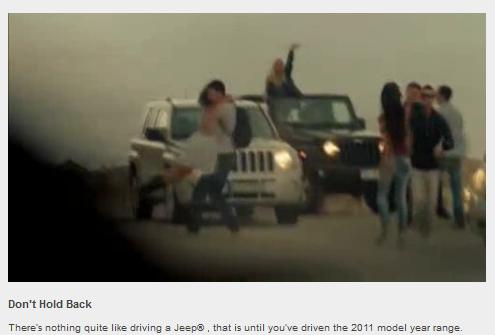 Jeep Australia’s current advertising message ‘Don’t Hold Back’ showing beach fun with their Jeep 4WDs
Jeep Australia’s current advertising message ‘Don’t Hold Back’ showing beach fun with their Jeep 4WDs
.
In December 2010, Fraser Island Hoon Tourism’s reputation saw a drunk 32-year old American tourist tragically drowned. He was taking a midnight dip after drinking heavily near the Cornwalls Camping Ground, on the eastern side of the island, six kilometres north of Eurong at about 4.30am. Some responsible tour group! The American man from Nevada in the United States was travelling with a backpacking tour group and had been drinking heavily before he decided to go for a swim about midnight..
[Source: ‘Dead tourist found on Fraser Island‘, by Marissa Calligeros, Brisbane Times, 20101210, ^http://www.brisbanetimes.com.au/queensland/dead-tourist-found-on-fraser-island-20101210-18rrl.html].
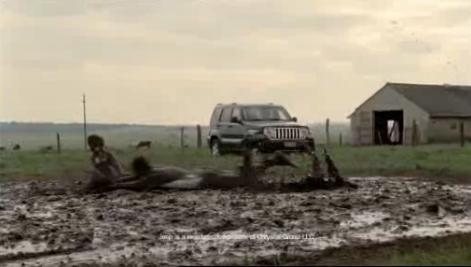 Jeep Australia advertising advocating the hoon element in the mud
Jeep Australia advertising advocating the hoon element in the mud
.
In December 2009, a 4WD ‘troop carrier’ hired by Japanese tourists rolled on Fraser Island’s Eastern Beach near Dundabara killing one Japanese tourist and injuring seven others aged between 20 and 30 years of age. The crash site was close to the location where two British backpackers died in April 2009 when their 4WD also rolled on the beach.
On Thursday and Friday, Transport Department safety inspectors were forced to turn around almost half of the hire vehicles making their way to Fraser Island from River Heads at Hervey Bay and from Inskip Point.
Of the 50 vehicles inspected, 17 were refused because of faulty brakes, faulty tyres, nine vehicles were overloaded and too heavy, while a further nine were ruled out completely because they were “defective”.
The 4WD Hire Industry for Fraser Island is clearly also out of control.
.
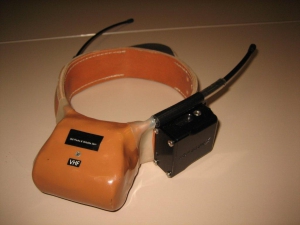 Radio Collars should be fitted to Fraser Island Tourists
Photo © Jennifer Parkhurst
Radio Collars should be fitted to Fraser Island Tourists
Photo © Jennifer Parkhurst
.
Hoon Tourism is out of control. Between 2004-2009 there were 106 casualties on Fraser Island from 4WD hooning..
[Source: ‘One dead, seven injured in Fraser Island 4WD rollover‘, by Tony Moore, Brisbane Times, ^http://www.brisbanetimes.com.au/queensland/one-dead-seven-injured-in-fraser-island-4wd-rollover-20091213-kq2t.html].
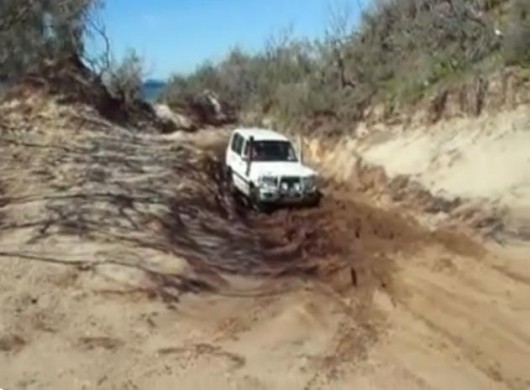 Fraser island 4×4 4wd stuck lol 100 series landcruiser
Watch Video: ^http://www.youtube.com/watch?v=VFqYCsUu56g
Fraser island 4×4 4wd stuck lol 100 series landcruiser
Watch Video: ^http://www.youtube.com/watch?v=VFqYCsUu56g
.
The Australian Government is supposed to be the custodian for the World Heritage Area that is ‘Fraser Island‘.
Yet in it’s laziness, it has delegated that custodial responsibility to the Queensland Government, and like most state governments in Australia, the Queensland Govermnment is under-funded to be able to adequately execute its management responsibilities to properly protect Fraser Island’s World Heritage values.
Fraser Island was inscribed on the World Heritage List by UNESCO in 1992 in recognition of its natural values – the island’s “exceptional natural beauty“. The two criteria upon which the island was listed were World Heritage Natural Criteria (ii) and ( iii ).
- Natural Criteria (ii): ‘Outstanding examples representing significant ongoing geological processes’
- Natural Criteria (iii): ‘Outstanding examples representing on-going biological processes’
Fraser Island’s long beaches and dune heathlands, its majestic tall Turpentine rainforests and many freshwater lakes and swamps provide vital habitat for over 230 species of birds including migratory wading birds and the endangered ground parrot. It is home to frogs, bats and flying foxes and the top order predator is the Dingo. The dingo population on the island is regarded as the most pure strain of dingoes remaining in eastern Australia.
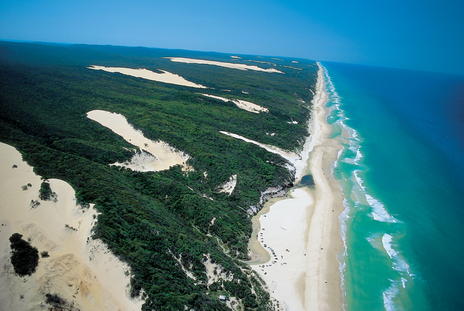 Fraser Island’s Seventy-Mile Beach – An encouraged Hoon Mecca!
Fraser Island’s Seventy-Mile Beach – An encouraged Hoon Mecca!(Photo by Tourism Queensland)
.
The whole of the island is part of Great Sandy National Park and is supposed to protected under the Nature Conservation Act 1992 and the Recreation Areas Management Act 2006 to the low water mark. But that is on paper perhaps to keep UNESCO appeased in its Paris headquarters on the other side of the planet. Whereas the onground reality is that the Queensland Government’s Department of Environment and Resource Management (DERM) is more focused on exploiting the island for its tourism potential and revenue.
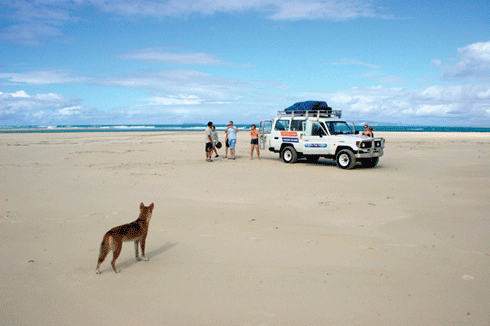 Dingoes and Tourists do not mix
Photo © Jennifer Parkhurst
Dingoes and Tourists do not mix
Photo © Jennifer Parkhurst
.
The Recreation Areas Management Act 2006 is useless in respect to 4WD users. Clause 109 ‘Unlawful use of motor vehicles’ states: ‘A person must not take a motor vehicle into a recreation area or drive or ride a motor vehicle in a recreation area unless the taking, driving or riding is authorised by a vehicle access permit, commercial activity permit or commercial activity agreement.’ Any licenced driver can get a vehicle access permit for Fraser Island.
Permits to drive on Fraser Island are unlimited and cost around just $40 per vehicle and can be booked online. So with four yobs on board, $40 is equivalent to the cost of just two beer cans each, which clearly has not proven to be a serious hoon hurdle.
There is no shortage of barges servicing Fraser Island from the mainland mainly by Fraser Island Barges, three times a day from two locations – Inskip Point and River Heads.
Camping permits are similarly cheap. So Fraser Island has become a free-for-all, encouraged by Labor Government visitation maximising policy and facilitated by commercial tourism operators, such as the ones hiring out the 4WD’s. And so the hoons are attracted in groups to party hard on the island.
Ever since 1992, when Fraser Island was first inscribed on the World Heritage List, the World Conservation Monitoring Centre of the IUCN at the time summarised:
.
“The Effects of heavy 4WD traffic on the beaches have unknown impacts on littoral (shoreline) fauna and control measures may soon be needed. The legal status of the portion of Fraser Island that is not a national park is under review and many changes in favour of conservation are anticipated.”
.
Since then the only changes have been more tourists under successive predominantly Queensland Labor Governments -under the premierships of Wayne Goss, Peter Beatie and Anna Bligh.
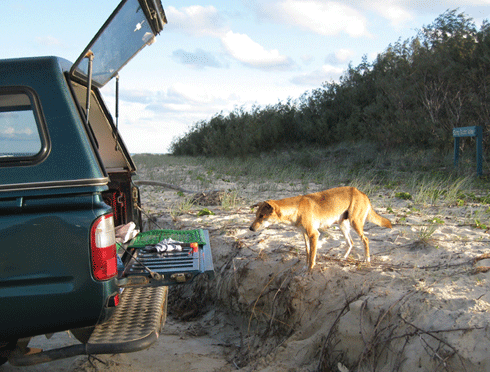 4WD Tourism out of control
This young Dingo mother of seven pups, her tagged right ear permanently flopped over, searches the beach and tourist vehicles for fish offal.
(Photo by Nick Alexander)
4WD Tourism out of control
This young Dingo mother of seven pups, her tagged right ear permanently flopped over, searches the beach and tourist vehicles for fish offal.
(Photo by Nick Alexander)
...
Tourism and Dingoes don’t mix
.
Last Saturday (20120728), a group of tourists got drunk on at the K’Gari Education Centre, north of Happy Valley near Eli Creek on Fraser Island. One of them, a drunk German 23-year old man stumbling inebriated way from a tour group about 2am Saturday. As he slept it off on a track, he was attacked by at least two wild Dingoes, native to the island.
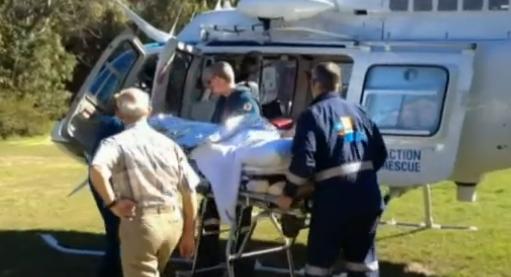 July 2012: A German tourist is in hospital being treated for serious injuries after being attacked by a dingo.
July 2012: A German tourist is in hospital being treated for serious injuries after being attacked by a dingo.
.
What was the response by the DERM Parks and Wildlife Service (QPWS) Regional Manager, Ross Belcher?
“Patrols will be increased…The attack would not bring changes to the way dingoes were managed, although a current review might lead to safer interactions.”
In contrast, Island World Heritage Area community advisory committee member Mike West said the dingoes were probably just messing around.
“If they weren’t messing around, he’d be dead,” he said. K’Gari was a problem because the local pack had substantial interaction with humans and appeared tame to many backpackers.
“As long as dingoes feel comfortable with people, there’ll always will be trouble,” Mr West said. “This only happens on Fraser where lots of people interact with dingoes. It appears rangers are going to have to try harder to get the message across.”.
In the past 12 months to June, ten people have been reported bitten by Dingoes. DERM has seen fit to then kill three Dingoes, like a linch mob. So much for protected World heritage. The World Heritage management culture in Queensland is that World Heritage is a brand designed to lure tourists, so it is all about maximising visitation tourists come first; whereas wildlife are fair game.
.
[Source: ‘The drunken, sleeping tourist was lucky to survive Fraser Island dingo attack‘, by Brian Williams, The Courier-Mail, 20120730, ^http://www.couriermail.com.au/news/queensland/the-drunken-sleeping-tourist-was-lucky-to-survive-fraser-island-dingo-attack/story-e6freoof-1226438003277]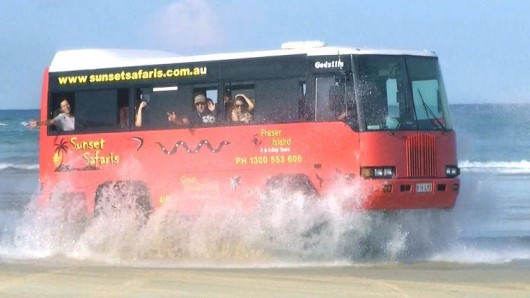 Fraser Island Party Hard Bus Tours
Fraser Island Party Hard Bus Tours
.
Dingo Linching Record
.
In 1980, when a dingo was reported having taken baby Azaria Chamberlain from a tourist campers tent near Uluru, a self-righteous testosterone-fueled media went into a frenzy. Dingos were demonised and persecuted, until the media turned their persecution on to the mother for the next 30 years. At the time, as a public gesture, the Northern Territory Government went on a kneejerk dingo linching crusade, culling 31 dingoes around Uluru. Chief Ranger at Uluru between 1968 and 1985, Derek Roff, had previously warned of the treat of dingoes to tourists. Roff had also advocated culling dingoes, but that was 1980, a tourist-centric 1980.
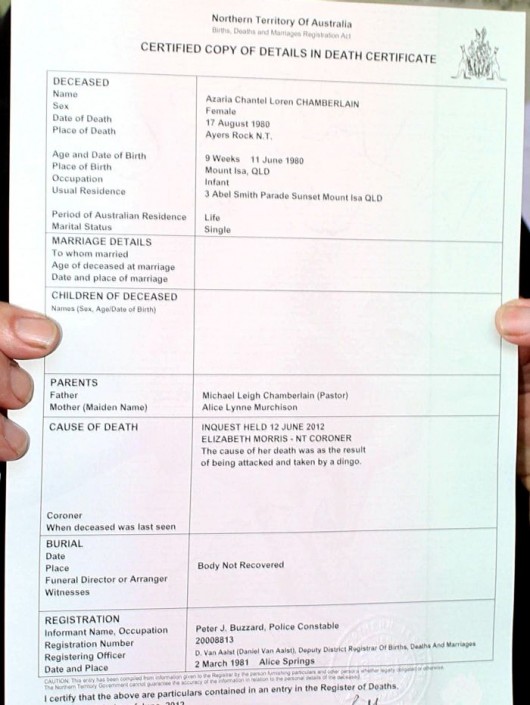 Azaria Chamberlain’s revised death Certificate 32 years later
Australia in denial for 32 years that a Dingo could have killed a baby
Azaria Chamberlain’s revised death Certificate 32 years later
Australia in denial for 32 years that a Dingo could have killed a baby
.
In 1994, after a young child was mauled by a dingo on Fraser Island, the media called for dingo linching. The Queensland Government, championing tourism safety on the island ordered the linching. During the following six years 103 dingoes were culled.
In 2001, a nine-year-old schoolboy, Clinton Gage, was fatally mauled by a dingo on Fraser Island. Predictably there was another media outcry, and a further 32 dingoes were culled within a matter of a few weeks.
The dingo was demonised as if a feral pig or a wild feral dog. DERM’s baby-boomer management perpetuated a tourist-centric mindset, adopting standard management practice to kill any ‘aggressive’ dingo or a dingo that ‘shows no fear of humans’. And this organisation is the custodian of Fraser Island World Heritage and its fauna and flora? Some parts of Australian society remain quite backward.
The way the Island is being loosely managed by DERM, it is only a matter of time before there is an other Dingo attack, and with all the children and infants brought on to the island, it is only a matter of time before there is another Azaria Episode. The only ethical sympathy warranted will be for the Dingo.
Earlier this month, Environment Minister Andrew Powell appointed noted University of Queensland ecologist Hugh Possingham to oversee a review of the Fraser Island Dingo Management Strategy by consultancy EcoSure. Let’s hope that Powell recognises that wild animals and tourists don’t mix.
.
“No longer will Australia be able to say that dingoes are not dangerous and only attack if provoked.”
~ Mrs Creighton-Chamberlain 2012
[Source: ‘Coroner finds dingo took baby’, by Clementine Norton, 20120612, ^http://www.frasercoastchronicle.com.au/story/2012/06/12/evidence-clears-lindy-chamberlain/].
Queensland Government only interested in Fraser Island tourism values
.
 Under the previous Bligh Labor Government, the attitude towards National Parks like Fraser Island was all about tourism. Under Bligh Labor’s strategic plan labelled ‘Q2: Tomorrow’s Queensland‘, national parks across Queensland were not afforded protection under a conservation strategy, but relegated instead under Bligh Labor’s ‘Queensland Outdoor Recreation Strategic Framework 2010‘. And who better to give the job of running DERM to, but one’s husband. In Queensland, like paraochial Tasmania, political nepotism is rife. Premier Anna Bligh’s husband, Greg Withers was in charge of DERM’s Office of Climate Change since its inception four years ago.
Under the previous Bligh Labor Government, the attitude towards National Parks like Fraser Island was all about tourism. Under Bligh Labor’s strategic plan labelled ‘Q2: Tomorrow’s Queensland‘, national parks across Queensland were not afforded protection under a conservation strategy, but relegated instead under Bligh Labor’s ‘Queensland Outdoor Recreation Strategic Framework 2010‘. And who better to give the job of running DERM to, but one’s husband. In Queensland, like paraochial Tasmania, political nepotism is rife. Premier Anna Bligh’s husband, Greg Withers was in charge of DERM’s Office of Climate Change since its inception four years ago.
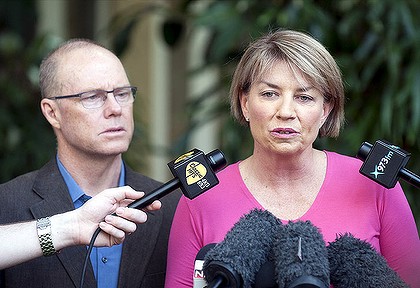 DERM Director for 4 years, Greg Withers, with his wife Labor Premier Anna Bligh after her election defeat.
Photo: Harrison Saragossi
^http://www.brisbanetimes.com.au/queensland/blighs-husband-cleans-out-his-desk-20120327-1vvo1.html
DERM Director for 4 years, Greg Withers, with his wife Labor Premier Anna Bligh after her election defeat.
Photo: Harrison Saragossi
^http://www.brisbanetimes.com.au/queensland/blighs-husband-cleans-out-his-desk-20120327-1vvo1.html
.
A visit to the DERM website on Fraser Island shows that the focus is all for the 4WD tourist:
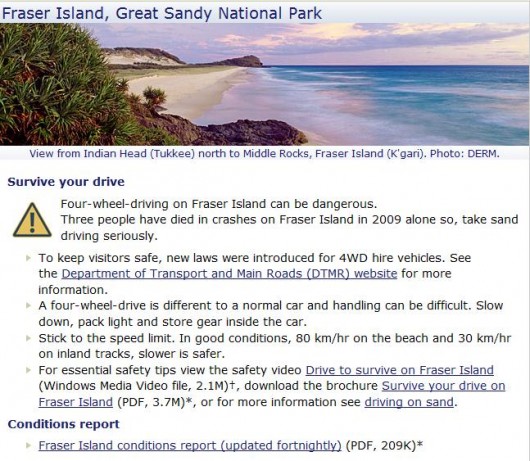 DERM website all about tourism on Fraser Island
^http://www.derm.qld.gov.au/parks/fraser/index.html
DERM website all about tourism on Fraser Island
^http://www.derm.qld.gov.au/parks/fraser/index.html
.
This is DERM’s official map for Fraser Island – seems all about tourists doesn’t it? The map is probably not sent to UNESCO in Paris.
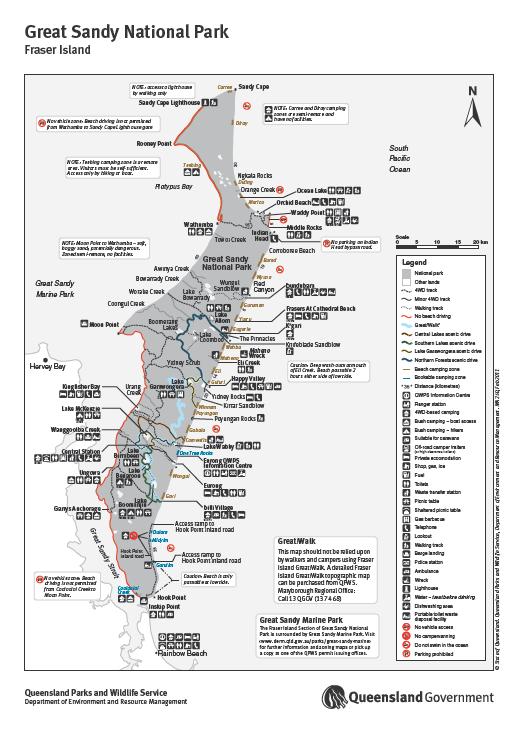 ^http://www.derm.qld.gov.au/parks/fraser/pdf/fraser-island-map.pdf
[>Read Larger Map]
^http://www.derm.qld.gov.au/parks/fraser/pdf/fraser-island-map.pdf
[>Read Larger Map]
.
Fraser Island’s Dingo population shrinking
.
So DERM is allowing free-for-all tourism across Fraser Island. It is estimated that around half a million visitors, many from overseas, visit Fraser Island each year.
How can this be sustainable? It simply isn’t – certainly not for the native Dingoes. Apparently, one of Fraser Island’s promoted attractions besides the beaches and sand dunes is the thrill of seeing a dingo ‘in the wild’. So the Fraser Island tourism marketing message is to see dingos. How bloody sad that colonial persecution has created rarety that is has become a tourism attraction? It is comparable to the Tasmanian warped fascination with the Thylacene that last century their forefathers were only too happy to cull into extinction.
Fraser Island residents, tour operators and animal welfare groups have reported the rapidly shrinking dingo population to DERM in 2009.
Eigh years prior, in 2001, DERM had compiled its Dingo Management Strategy. The document may have well been written by the New South Wales Game Council itching for target practice. DERM’s Dingo Management Strategy was anathema to the World Heritage protection. The strategy had a mindset of ‘Pest Control’ with the prescribed culling of dingoes, where tourist could do no wrong and travel freely. If the dingo caused a problem its was shot. The only human controls were token ‘public education’. Dingoes were trapped, relocated and fenced away from free-roaming tourists.
.
DERM: “..when authorised, the trapping and destruction of problem dingoes.”
.
In 2009, an authority on the Dingo and former CSIRO researcher, Dr Laurie Corbett, was called in to review the current strategy and respond to the public concerns about falling dingo numbers on Fraser Island.
Those concerned about the fate of Fraser Island dingoes – including researcher Dr Luke Leung from Queensland University – now fear the population has been reduced to around 100 animals and their genetic viability over the long term is being compromised.
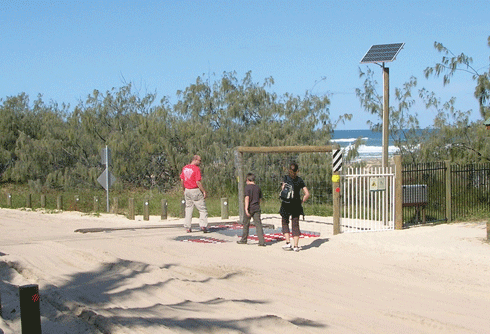 At Eurong village (Fraser Island) tourists wilfully disregard DERM signs
and walk across an electrified grid which has filled with sand.
At Eurong village (Fraser Island) tourists wilfully disregard DERM signs
and walk across an electrified grid which has filled with sand.(Photo by Nick Alexander)
.
DERM’s Dingo Management Strategy with its prescribed kneejerk response to any dingo ‘identified as dangerous’ by killing it, simply chose to ignore known dingo pack behaviour. Killing an adult dingo can dislocate the dingo pack structure. The pack relies on these elders to maintain the social order, and help teach the younger animals how to hunt.
Tim Rivers, a tour operator who has been involved with visitors to the area for more than 30 years, is alarmed at the now low levels of dingo sightings on the island, and suggests that the official figures of dingo numbers are overstated. He believes many more dingoes have been culled than the DERM Queensland Parks and Wildlife Service are prepared to admit, and is concerned the kills have not always been clean and humane. Rivers claims having seen ‘animals with gunshot wounds in shoulders, hindquarters and even facial wounds’.
Part of the management strategy is to keep dingoes off the beach and away from tourist areas by means of ‘hazing’. This involves attempting to scare dingoes away by shanghai-ing them with pellets. Opponents of the management plan feel this practice is cruel, and consider that it can only add to the dingoes’ mistrust of humans and heighten their antagonism.
Another contentious issue is that of ear-tagging dingoes on the island. Dingo pups as young as four months have been trapped and marked with a tag in their ear. Opponents of this practice consider it cruel and debilitating. The ear sometimes becomes infected and the tag may cause the pup’s ear to flop over. This impedes its ability to discriminate the direction from which a sound is coming – something critical when the pup is learning to hunt for food. In some cases the trapping of an animal in order to tag it has also led to a leg being damaged or broken, further limiting its ability to survive ‘in the wild’.
It is hard to reconcile the ear-tagging and ‘hazing’ of dingoes with the QP&WS’s ‘cardinal principle’ of park management: ‘to provide, to the greatest possible extent, for the permanent preservation of the area’s natural condition and the protection of the area’s cultural resources and values’. The activities, apart from their potentially inhumane aspects, are seemingly at odds with the principle of regarding dingoes as wild, native animals and interfering with them as little as possible.
In his 2009 audit of the dingo management strategy, Dr Laurie Corbett defends the issue of tagging so that rangers can identify a ‘problem’ animal easily. He recommends the continued use of slingshots and ‘rat-guns’ as the most effective ‘hazing’ methods, despite the fact many dingoes now recognise the rangers’ vehicles and will flee from them on sight.
Some of the long-term residents of the island point out that there were few dingo problems during the time of Forest Department control. For years, the dingoes were allowed to roam freely through the resorts and small settlements and the feeding of food scraps was actually encouraged. Now the QP&WS has erected a ‘dingo-proof’ fence with electrified ‘cattle grids’ around some of the settlements. The one surrounding the community of Eurong cost $1 million, requires constant maintenance and is still not 100 per cent effective in keeping dingoes out.
The real problem, according to long-time resident Judi Daniel, is the visitors’ lack of common sense. Many of the dingo ‘incidents’ that have led to the destruction of the dingoes involve unsupervised children. ‘Why must a dingo die due to visitors’ stupidity?’ she asks.
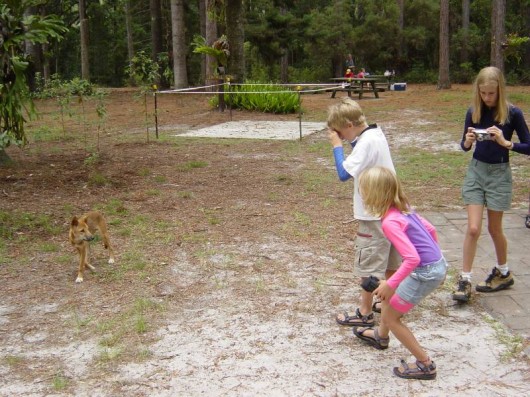 Tourist children out of control on Fraser Island
Tourist children out of control on Fraser Island
.
Despite the efforts of the pro-dingo alliance, there are still many in the community who consider that ‘the only good dingo is a dead dingo’. The spectre of another attack on a child led one former Queensland postman, writing to the Fraser Coast Chronicle, to argue that: ‘One child’s life is worth more than 100 dingoes.’
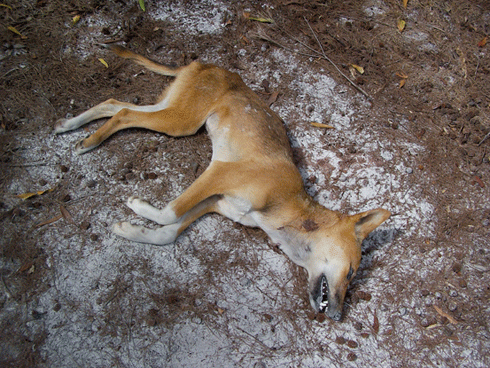 This dingo, with a bullet wound in its neck, was discovered by a tour operator in January last year at Lake Mckenzie.
This dingo, with a bullet wound in its neck, was discovered by a tour operator in January last year at Lake Mckenzie.(Photo by Caroline Hanger)
.
With feelings like this common in the wider community, those who are striving to achieve a better deal for the Fraser Island dingo are facing an uphill battle. Terry Harper, the government’s Senior Director, Marine Parks, has just announced another ‘population dynamics’ study, but this is still in its ‘planning and scoping’ stage, with no time-frame set for its completion.
Researcher Dr Luke Leung believes that, with only six or seven packs left on the island, the time has come for a more ethical and humane approach. For instance, he says, ‘problem’ animals could be relocated from the island to a breeding facility in order to maintain the gene pool of this relatively pure strain of dingo.
In the meantime, Humane Society International has called for an immediate end to the culling of dingoes on Fraser Island and for better education of tourists visiting the island on how to interact with the dingoes.’
[Source: ‘Concerns heightening for Fraser Island’s dingoes’, by Nick Alexander, 2009, Ecos Magazine, ^http://www.ecosmagazine.com/?paper=EC151p18].
World Heritage is primarily about recognition and respect for the natural world, not about tourism branding, exploitation and maximisiing visitation.
In the two decades that the Queensland Government has held the custodian reigns of Fraser Island, it has failed its custodial responsibilities utterly. State Governments cannot be trusted with National Park custodianship.
World Heritage and National Park management can only be entrusted at a national level. Fraser Island’s World Heritage needs to be managed at national jurisdiction where it can be effected properly to the spirit of World Heritage protection and conservation principles and supported with national resources – skills, and funding. Fraser Island Dingoes should be allowed to remain free to roam in the wild in their natural habitat without the incursion of tourists – hoons o otherwise. Tourism on Fraser Island has proven to be exploitative and a key threatening process to the future survival of Fraser Island’s top order predactor. Dingoes should not suffer because of the intervention of humans.
Australia’s remnant pure Dingos deserve humanity’s respect before they befall the same extinction fate as the Thylcene.
It is time to ban all tourism from Fraser Island and to dedicate the island as the world’s only surviving sanctuary for the Pure Dingo.
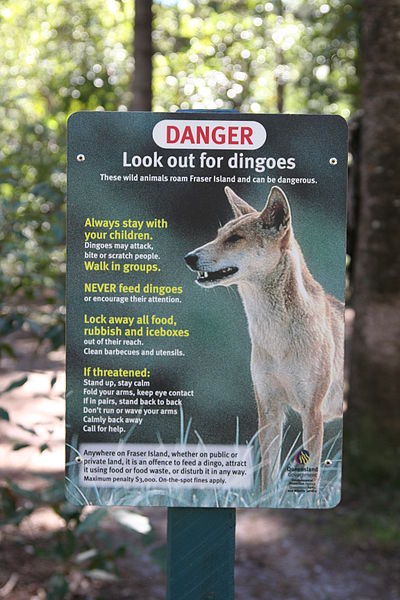 Token Signage
Token Signage
.
Related ‘Habitat Advocate’ Articles:
.
>Dingo Ecology deserves respect on Fraser Is
.
>Remove all ferals from Fraser Island
.
>Dingo: Australia’s ancient apex predator at risk
.
.
Further Reading:
.
[1] Queensland Bligh Labor Government’s Response to the Queensland Outdoor Recreation Federation Policy Proposal, (undated) ^http://www.qorf.org.au/_dbase_upl/Labor_Response_to_QORF_Policy_Proposal.pdf [>Read Document]
.
[2] ‘More Recreation in our National Parks‘, by the Bligh Labor Government, 17 March 2012), ^http://www.queenslandlabor.org/wp-content/uploads/FOR-RELEASE-National-Parks-1.pdf [>Read Document]
.
[3] ‘Audit (2009) of Fraser Island Dingo Management Strategy‘, by L K Corbett, August 2009 ^http://www.derm.qld.gov.au/register/p03023aa.pdf,
[>Read Document]..
[4] Legislation governing Fraser Island: ‘Recreation Areas Management Act 2006 (Qld)‘, ^http://www.legislation.qld.gov.au/LEGISLTN/ACTS/2006/06AC020.pdf, [>Read Document]
.
[5] ‘Fraser Island World Heritage Nomination‘, 1992, (IUCN Summary),^http://whc.unesco.org/en/list/630/, [Read Document]
.
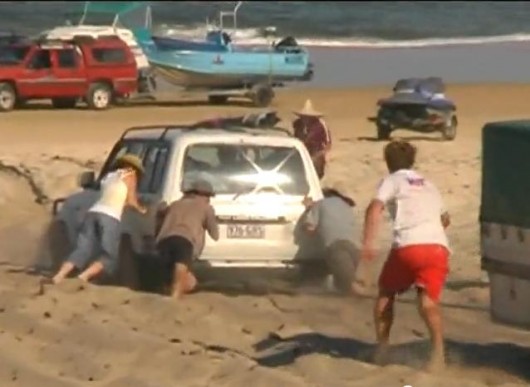 Click to watch Video: ^http://www.youtube.com/watch?NR=1&feature=endscreen&v=R6O5GljsIxo
Click to watch Video: ^http://www.youtube.com/watch?NR=1&feature=endscreen&v=R6O5GljsIxo







